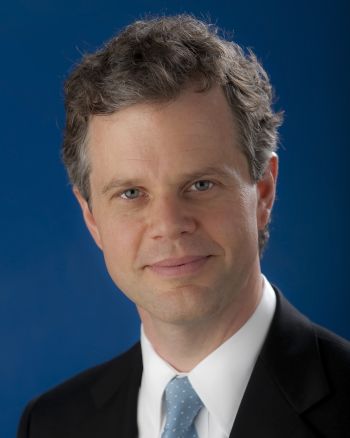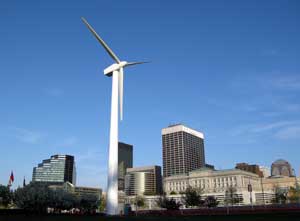This is part of a series of interviews with people working to make U.S. communities smarter, greener spaces. Got a suggestion for an interviewee? Send it our way or leave it in the comments section below.
Earlier this year, officials from sixteen U.S. cities gathered in Cambridge, Mass., to compare notes on a surprisingly hot topic: building retrofits. The meeting was held just as the Obama Administration announced the creation of a “Recovery through Retrofit” interagency working group, and hopes were high that federal funding, green jobs, and energy savings would flow forth. I dropped in on that event and spoke with Stockton Williams of conference sponsor Living Cities, a coalition of foundations and banks — including such heavyhitters as the Gates Foundation, Morgan Stanley, and Deutsche Bank — that aims to “improve the lives of low-income people and the urban areas in which they live.” Brimming with quiet confidence, he’s one of those people who leaves you feeling like good things actually can happen — and are happening. I decided to follow up with him to see what came out of the conference, what he thinks of Obama’s urban efforts so far, and what advice he has for the rest of us.
Q. Tell the good people: what is your occupation, and what does it look like on a day-to-day basis?
 Stockton WilliamsA. I am senior advisor and director of green economy initiatives for Living Cities, a consortium of global foundations and financial institutions that invests in local efforts to expand opportunity for low-income people in U.S. cities. I work with cities and nonprofit organizations to design and implement building energy retrofit initiatives and other strategies to create clean energy jobs and foster more sustainable urban development. I also work with federal, state, and local officials to develop policies that will make the green economy work for low-income people and places.
Stockton WilliamsA. I am senior advisor and director of green economy initiatives for Living Cities, a consortium of global foundations and financial institutions that invests in local efforts to expand opportunity for low-income people in U.S. cities. I work with cities and nonprofit organizations to design and implement building energy retrofit initiatives and other strategies to create clean energy jobs and foster more sustainable urban development. I also work with federal, state, and local officials to develop policies that will make the green economy work for low-income people and places.
Some of what we do involves making grants and loans, which is critically important to getting innovative efforts off the ground. Just as important, we think, is the role we play as a convener of leaders on various issues and source of unbiased expertise and real time market intelligence on the most promising approaches for strengthening cities.
Q. When we met earlier this year, you were at a “Boot Camp” for officials from several cities around the country. How was that experience, and what came out of it?
A. The Living Cities Green Boot Camp convened more than 100 senior local officials and their partners in the energy and workforce sectors from 16 cities for two days of discussion and peer networking on scaling up building energy retrofits. These cities are at the forefront of a growing recognition in communities across the country that building retrofits at scale can create substantial economic and environmental benefits, from progress on climate change to lower costs and new jobs.
At the boot camp we learned a lot about what cities are trying to do, and where they still face challenges. Ensuring that local retrofit initiatives create opportunities for low-income people is one of them. Since the Green Boot Camp, most participating cities have made a lot of progress. We are providing funding and technical support to a number of them individually and creating ways for all of the participants to learn from and support each other’s efforts.
Q. Which cities — either among those who attended the camp or in general — do you think are doing the best job of becoming smarter, greener places to live?
 A new wind’s blowing in Cleveland.GCBL.orgA. There is an enormous amount of environmental innovation happening at the local level in all parts of the country. At Living Cities, we are focused on how cities are making the clean energy economy work for low-income people. On that score, Chicago, Cleveland, Minneapolis-St.Paul, Newark, Philadelphia, Kansas City, Los Angeles, San Francisco, and Seattle are certainly among the national leaders.
A new wind’s blowing in Cleveland.GCBL.orgA. There is an enormous amount of environmental innovation happening at the local level in all parts of the country. At Living Cities, we are focused on how cities are making the clean energy economy work for low-income people. On that score, Chicago, Cleveland, Minneapolis-St.Paul, Newark, Philadelphia, Kansas City, Los Angeles, San Francisco, and Seattle are certainly among the national leaders.
Smaller cities like Babylon, N.Y., Charlottesville, Va., and Flagstaff, Ariz., are also doing leading edge work in the area of retrofits.
Q. We occasionally run a column called “Sexy Retrofits,” in which we take a look at high-profile buildings that are getting greener. What role does retrofitting play in fighting climate change, and do you think such splashy projects help the cause or are a distraction?
A. The homes, apartments, commercial properties, and community facilities all around us are a major opportunity for achieving greater efficiency and reducing global warming pollution. Buildings in the U.S. consume 72 percent of the electricity and 55 percent of the natural gas — and account for 40 percent of greenhouse gas emissions. Off the shelf technologies and common sense construction practices can cut building energy use by as much as 40 percent. In the process, building retrofits save money, reduce carbon emissions, and create jobs. Critically, many retrofit jobs — from construction to audits to property management — offer opportunities to train low-income workers for long-term careers.
Splashy projects can be beacons of innovation and inspiration, as long as they are understood as such. But most of the climate benefit from better buildings comes from the less sexy improvements — unless you think a caulking gun is sexier than a solar panel.
Q. What are the biggest challenges that officials intent on creating more sustainable cities face?
 Sign of the times.A. One set of challenges is related to the recession and foreclosure crisis, which has hammered city budgets, forced cutbacks in essential services, and limited many cities’ ability to make the progress they had hoped on climate protection plans. Another set of challenges flow from the reality that a true clean energy economy is only just emerging in this country, so local governments, like the rest of us, are still learning how to make the transition.
Sign of the times.A. One set of challenges is related to the recession and foreclosure crisis, which has hammered city budgets, forced cutbacks in essential services, and limited many cities’ ability to make the progress they had hoped on climate protection plans. Another set of challenges flow from the reality that a true clean energy economy is only just emerging in this country, so local governments, like the rest of us, are still learning how to make the transition.
Finally, public policies are often a barrier to greener cities. These include federal transportation programs that encourage excessive road building and sprawl, housing policies that drive demand for larger homes on larger lots away from the urban core, and energy policies that underinvest in incentives for energy efficiency and renewable energy in the built environment. They also include local building codes, zoning policies, stormwater management procedures, and land-use requirements that undermine and sometimes prevent cooler, smarter, and greener growth and development. The good news is that public policy as well as consumer demand is clearly starting to shift; both are demanding greener cities, and as the economy recovers, we will see much faster progress at the local level.
Q. As you look at the current administration’s actions on urban and transportation issues so far, what jumps out as the most promising? What do you wish they’d put more emphasis on?
A. The administration has made a strong commitment to environmental sustainability as a central priority in its broader urban and transportation policies, stronger than any previous administration. We will see this reflected in the renewed debate this fall on cap and trade legislation and the forthcoming rewrite of the major transportation laws.
More broadly, there is an unprecedented degree of joint policymaking occurring between the federal departments of housing, transportation, energy, labor and the Environmental Protection Agency on sustainability issues. One example is the Recovery through Retrofit Interagency Working Group, which is developing a comprehensive blueprint for retrofitting the nation’s residential housing stock.
We are working with the administration to make sure policies to spur the clean energy economy also expand opportunity for low-income people. That cannot be an afterthought; it needs to be at the top of the list. The administration has very talented, dedicated people working on this, but prior experience and current budget and political realities underscore the need to be vigilant, relentless, and insistent on this point.
Q. If you could wave your magic wand and make one thing happen in every city right now, what would it be?
A. Cities would have the resources to meet the basic needs of their citizens, with a little left over — and more available from the federal government to reward the leaders — to accelerate their transition to being greener communities.
Q. Do you have any advice for how people can make change in their own communities?
A. Our economic and environmental future depends mostly on cities. Every citizen has a stake in their city’s plan — or lack of one — for responding to the catastrophic threat of climate change. Find out what your city is doing, ask how you can help, and send any message you can to your federal elected leaders that we can’t wait any longer to act as a nation.



